Abstract
We explore the dynamics of the sequence of Kasner quadrilaterals defined via a complex parameter . We extend the results concerning Kasner triangles with a fixed complex parameter obtained in earlier works and determine the values of for which the generated dynamics are convergent, divergent, periodic, or dense.
MSC:
51P99; 60A99
1. Introduction
For a real number and an initial quadrilateral , one can construct the quadrilateral such that , , , and divide the segments , , and , respectively, in the ratio . Continuing this process, one obtains the terms , whose terms are referred to as Kasner (or nested) quadrilaterals (after E. Kasner (1878–1955) who initiated these studies). A natural problem is to find the numbers for which the sequence is convergent.
The related dynamic geometries inspired by simple iterations (especially for triangles) are reviewed in the article [1]:
generated by the incircle and the circumcircle of a triangle, the pedal triangle [2], the orthic triangle, and the incentral triangle. Similar recursive systems describing dynamic geometries are considered by S. Abbot [3], G. Z. Chang and P. J. Davis [4], R. J. Clarke [5], J. Ding, L. R. Hitt, and X-M. Zhang [6], L. R. Hitt and X-M. Zhang [7], and D. Ismailescu and J. Jacobs [8], or in the works by Dionisi et al. [9] and Roeschel [10]. In the paper [1], we proved that the sequence of Kasner triangles is convergent if and only if , also providing the order of convergence.
Here, we prove similar results for the Kasner quadrilaterals, given by the complex coordinates of their vertices , , , , (see the notation in [11]). The iterations are defined recursively for as:
In this paper, we investigate the dynamic geometry generated by the sequence , when is a complex number. Notice that when is complex, the quadrilaterals are not always nested. The work extends results for triangles in [12], preparing the ground for the study of the general case of Kasner polygons.
2. Preliminaries
The matrix T has the characteristic polynomial
whose roots can be written as and
A direct computation shows that
where the matrices F and are given by
3. Dynamical Properties in the Case of Real Parameter
In this section, we study the convergence of the sequence of the Kasner quadrilaterals when is a real number. By Formula (10), the sequences , , , and are convergent if and only if , , and , that is,
First, one can easily check that the condition is equivalent to .
Then, because is real, we clearly have ; hence, the conditions and become equivalent to , that is,
which is equivalent to , that is, .
4. Dynamical Properties in the Case of Complex Parameter
We now discuss the dynamics obtained when is a complex number.
It is convenient to define the following points
representing the centres of the open disks
and of the circles depicted in Figure 1
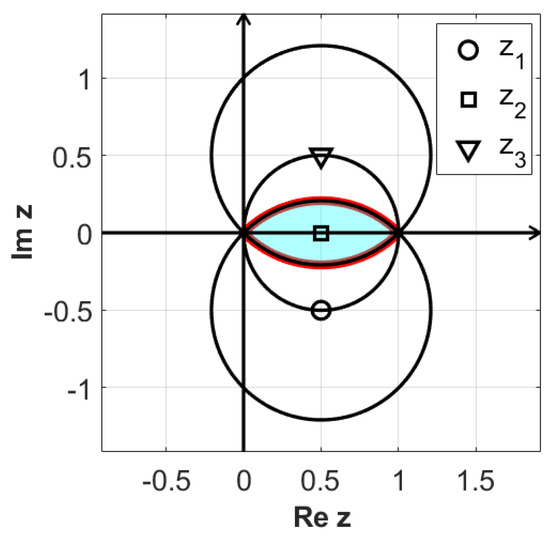
Figure 1.
Plots of the circles , , and defined in Formula (15).
Considering the real numbers , by (4), (5), and (6), we obtain
By (16), we deduce that for a given , if , then we have . Moreover, if , then it follows that . The distinct behaviours below emerge:
- If , then .One can easily check the set inclusion .
- If is in the interior of the complement of , then .
- If , then .
To describe the orbits of the sequences , , , and , one first needs to understand the behaviour of the sequence , where (see, for example, Lemma 2.1 in [13], or Lemma 5.2 in [14]), which is shown in Figure 2.
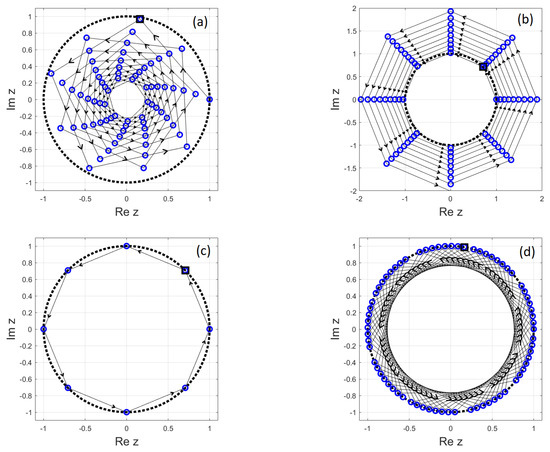
Figure 2.
The terms , obtained for (a) and ; (b) and ; (c) and ; (d) and . Arrows indicate the orbit’s direction, and the dotted line represents the unit circle. The point is shown as a square.
Lemma 1.
Let , where , . The orbit of is:
A spiral convergent to 0 for ;
A divergent spiral for ;
A regular gon if z is a primitive th root of unity, ;
A dense subset of the unit circle if and .
When is irreducible, then the terms of the spirals obtained in (a) and (b) align along k rays.
To prove part (d), we use that for and m integers. By Kronecker’s Lemma ([15], Theorem 442), the set is dense in the set of real numbers ; hence, the set is dense within the unit circle.
As linear combinations of , , and , the sequences , , , and , given by the explicit Formula (10) in the complex plane, exhibit the following behaviour.
Lemma 2.
The patterns produced by Formula (10) are summarized below:
- 1.
- Convergent if ;
- 2.
- Divergent if ;
- 3.
- Periodic if (that is, when or );
- 4.
- There are two distinct patterns when .Denoting if or if , then the orbit:
- (a)
- Has k convergent subsequences if is an irreducible fraction;
- (b)
- Is dense within a circle when θ is irrational.
The details of the geometric patterns obtained in each case are presented below.
In all figures, we consider the initial polygon of complex coordinates
for which Formula (11) gives the values
The position of relative to relevant boundaries is indicated in the left diagram with a star, while the iterations of the polygon are displayed on the right, where the star indicates the position of the centroid. All the simulations have been implemented in Matlab® 2021b.
4.1. Convergent Orbits
If , then by (16), the sequences , , and are convergent if and only if . Hence, by (10), we obtain that , , , and converge to . We can formulate the following result.
Theorem 1.
The following assertions hold:
- (1)
- The sequence is convergent if and only if .
- (2)
- When the sequence is convergent, its limit is the degenerated quadrilateral at , the centroid of the initial quadrilateral .
Proof.
The intersection is shaded in Figure 1.
Clearly, is equivalent to and (in this case, one also has ). The relation (10) shows that the sequences , , , and are convergent if and only if , , and are convergent, which happens when , , and .
Adding the equation in the system (1), one obtains that for every integer , we have , where is the complex coordinates of the centroid of the initial quadrilateral . Assume that , , , and . From system (1), we obtain
Because , the only solution of this system is . □
For , one has , and moreover, in this case, the vertices , , , are interior points of the segments , , , and , respectively. Such an example is depicted in Figure 3.
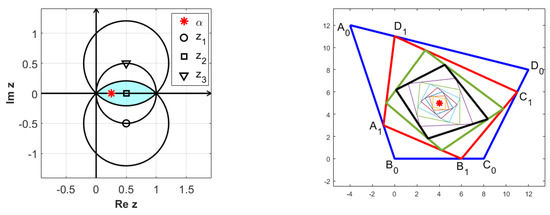
Figure 3.
Convergent orbits (right) obtained for (left).
On the other hand, when the parameter is not real, the orbit is convergent, but the points are not aligned any more, as illustrated in Figure 4.
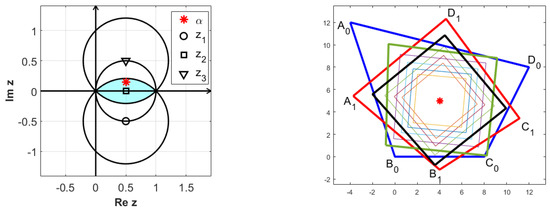
Figure 4.
Convergent orbits (right) obtained for (left).
4.2. Periodic Orbits
If , then and , which can only happen for .
Case 1. . From the system (1), for all , one obtains
Similarly, , , and , so the sequence terms satisfy
Case 2.. From the system (1), for all , one obtains
so, in this case, the sequences are actually constant.
4.3. Divergent Orbits
If , then ; hence, by (16), either or are divergent. By Formula (10), the sequences , , , and are divergent (as long as the corresponding coefficients M, N, P in (10) are not all vanishing).
Figure 5 shows a divergent iteration. The diagram on the left we plot the position of , while on the right side we illustrate the polygons , .
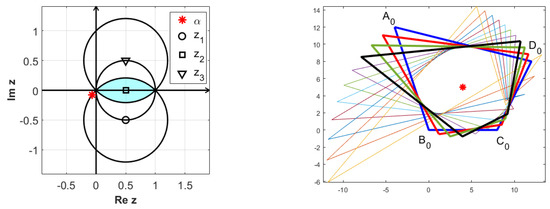
Figure 5.
Divergent orbits (right) obtained for (left).
4.4. Orbits with a Finite Number of Convergent Subsequences
If , then one either has for , or for . The orbit has a finite number of limit points if the complex argument of if or of if is rational.
4.4.1. Upper Arc of
First, assume that , i.e., is on the upper arc .
As , there is with , so by (16), we obtain
When is an irreducible fraction, the orbit has a finite number of convergent subsequences. Therefore, we have the following result.
Theorem 2.
If for the integers , we have is an irreducible fraction, then and by Formula (10), the sequences , , , and have subsequences which converge to the vertices of a regular gon centred at of radius .
Proof.
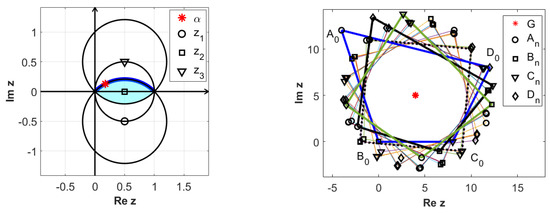

In this case, we have for and and , so using the notations of (10) and (11), one obtains the relations
which ends the proof. This case is depicted in Figure 6. The sequences , , , and are plotted in Figure 7. Moreover, one can check that for the limit polygon is a pentagon centred at , of radius (by (19)). □

Figure 6.
First 200 iterations (right) obtained for where (left).

Figure 7.
Iterations obtained for . (a) ; (b) ; (c) ; (d) .
4.4.2. Lower Arc of
Similarly, if , then is on the arc defined by (17). Therefore, there is with , and by (16), we obtain
The following result can be proved similarly to Theorem 2.
Theorem 3.
If for the integers , we have is an irreducible fraction, then and by Formula (10), the sequences , , , and have q subsequences convergent to the vertices of four regular gons centred at of radius .
The first 200 iterations obtained when are presented in Figure 8.
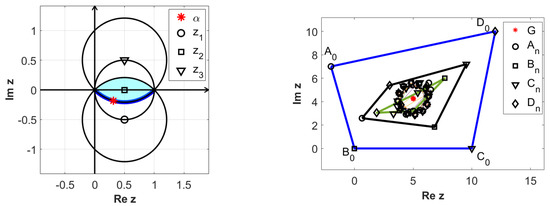
Figure 8.
First 200 iterations (right) obtained for where (left).
The sequences , , , and are plotted in Figure 9. Similarly to (23), the limit polygon is a hexagon centred at G, which has radius .
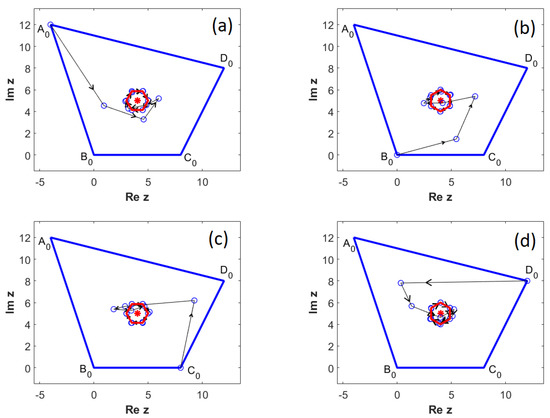
Figure 9.
Iterations obtained for . (a) ; (b) ; (c) ; (d) .
4.5. Dense Orbits
When but or are irrational modulo , the orbits of , , , and are dense within circles.
4.5.1. Upper Arc of
First, assume that , i.e., is on the upper arc . Using the notations in (22), the following result can be deduced from Lemma 1 (d).
Theorem 4.
If and is irrational, then the set of limit points for each of the sequences , , , and is the circle centred at of radius .
Proof.
Let z be an arbitrary point on the circle of centre and radius . If , then . Otherwise, denoting , we have . Because with irrational, by Lemma (1), it follows that there is a subsequence such that . For , one can find and such that
hence, for , one obtains
hence . This shows that z is a limit point for the sequence . Analogously, this is proved for , and . □
Figure 10 illustrates the position of and the polygons obtained for iterations, respectively, when . Figure 11 depicts the vertices of the original quadrilateral of affixes , , , and , and 200 iterations.
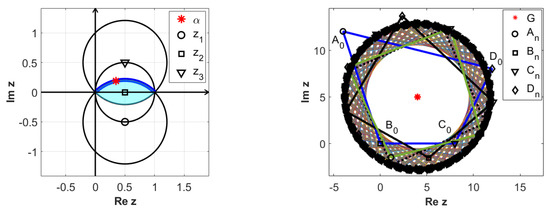
Figure 10.
Orbits for iterations (right), for (left).
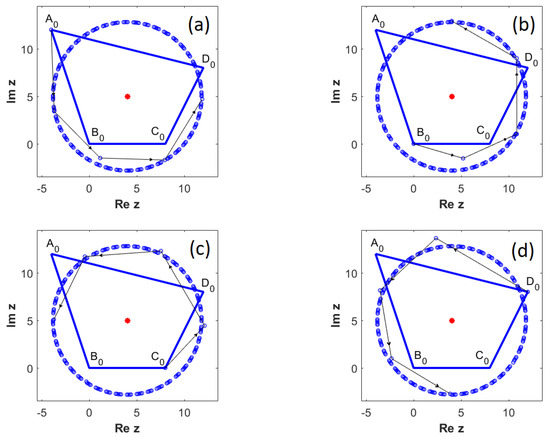
Figure 11.
Orbits for . (a) ; (b) ; (c) ; (d) .
4.5.2. Lower Arc of
When , is on the arc defined by (17), as in Figure 12. Using the notations in (24), we can formulate the following result.
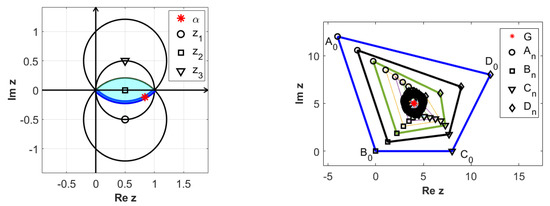
Figure 12.
Dense orbits obtained after iterations (right), generated for (left), when , with .
Theorem 5.
If and is irrational, then the set of limit points for each of the sequences , , , and is the circle centred at of radius .
Proof.
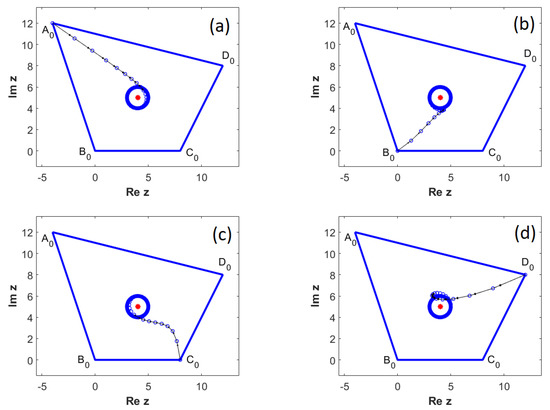
The proof follows the similar lines as for Theorem 4, but now by (10), one has . Because , , we obtain , where . Figure 12 shows the position of and the first iterations, respectively, when . Figure 13 plots the vertices of the original quadrilateral of affixes , , , and , and 200 iterations. □

Figure 13.
Orbits for . (a) ; (b) ; (c) ; (d) .
Author Contributions
All authors claim to have contributed significantly and equally to this work. All authors have read and agreed to the published version of the manuscript.
Funding
This research was funded by “1 Decembrie 1918” University of Alba Iulia through scientific research funds.
Acknowledgments
The authors wish to thank the referees for their valuable feedback and constructive comments, which helped to improve the quality of the manuscript.
Conflicts of Interest
The authors declare no conflict of interest.
References
- Andrica, D.; Bagdasar, O.; Marinescu, D.Ş. Dynamic geometry of Kasner triangles with a fixed weight. Int. J. Geom. 2022, 11, 101–110. [Google Scholar]
- Kingston, J.G.; Synge, J.L. The sequence of pedal triangles. Am. Math. Mon. 1988, 95, 609–620. [Google Scholar] [CrossRef]
- Abbot, S. Average sequences and triangles. Math. Gaz. 1996, 80, 222–224. Available online: https://www.jstor.org/stable/3620354 (accessed on 12 March 2022). [CrossRef]
- Chang, G.Z.; Davis, P.J. Iterative processes in elementary geometry. Am. Math. Mon. 1983, 90, 421–431. [Google Scholar] [CrossRef]
- Clarke, R.J. Sequences of polygons. Math. Mag. 1979, 90, 102–105. [Google Scholar] [CrossRef]
- Ding, J.; Hitt, L.R.; Zhang, X.-M. Markov chains and dynamic geometry of polygons. Linear Algebra Appl. 2003, 367, 255–270. [Google Scholar] [CrossRef]
- Hitt, L.R.; Zhang, X.-M. Dynamic geometry of polygons. Elem. Math. 2001, 56, 21–37. [Google Scholar] [CrossRef][Green Version]
- Ismailescu, D.; Jacobs, J. On sequences of nested triangles. Period. Math. Hung. 2006, 53, 169–184. [Google Scholar] [CrossRef]
- Donisi, S.; Martini, H.; Vincenzi, G.; Vitale, G. Polygons derived from polygons via iterated constructions. Electron. J. Differ. Geom. Dyn. Syst. 2016, 18, 14–31. Available online: http://www.mathem.pub.ro/dgds/v18/D18-do-b77.pdf (accessed on 7 April 2022).
- Roeschel, O. Polygons and iteratively regularizing affine transformations. Beitr. Algebra Geom. 2017, 58, 69–79. [Google Scholar] [CrossRef]
- Andreescu, T.; Andrica, D. Complex Numbers from A to … Z, 2nd ed.; Birkhäuser: Boston, MA, USA, 2014. [Google Scholar]
- Andrica, D.; Bagdasar, O. On the dynamic geometry of Kasner triangles with complex parameter. In Proceedings of the 7th IACMC 2022, Zarqa University, Zarqa, Jordan, 11–13 May 2022; Nature Springer: Berlin, Germany, 2022. accepted. [Google Scholar]
- Bagdasar, O.; Larcombe, P.J. On the characterization of periodic complex Horadam sequences. Fibonacci Quart. 2013, 51, 28–37. Available online: https://www.fq.math.ca/Papers1/51-1/BagdasarLarcombe.pdf (accessed on 10 December 2021).
- Andrica, D.; Bagdasar, O. Recurrent Sequences: Key Results, Applications and Problems; Nature Springer: Berlin, Germany, 2020. [Google Scholar]
- Hardy, G.H.; Wright, E.M. An Introduction to the Theory of Numbers, 5th ed.; Oxford University Press: Oxford, UK, 1979. [Google Scholar]
Publisher’s Note: MDPI stays neutral with regard to jurisdictional claims in published maps and institutional affiliations. |
© 2022 by the authors. Licensee MDPI, Basel, Switzerland. This article is an open access article distributed under the terms and conditions of the Creative Commons Attribution (CC BY) license (https://creativecommons.org/licenses/by/4.0/).